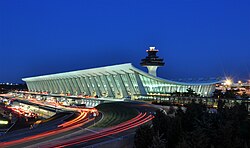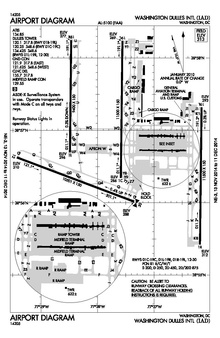فرودگاه بینالمللی دالس واشینگتن
فرودگاه بینالمللی دالس واشینگتن | |||||||||||||||||||||||||||
|---|---|---|---|---|---|---|---|---|---|---|---|---|---|---|---|---|---|---|---|---|---|---|---|---|---|---|---|
 | |||||||||||||||||||||||||||
 | |||||||||||||||||||||||||||
| خلاصه | |||||||||||||||||||||||||||
| نوع فرودگاه | Public | ||||||||||||||||||||||||||
| مالک-گرداننده | Metropolitan Washington Airports Authority | ||||||||||||||||||||||||||
| شهر بکار رفته | Washington metropolitan area | ||||||||||||||||||||||||||
| مکان | دالس، ویرجینیا و Chantilly, Virginia، ایالات متحده آمریکا | ||||||||||||||||||||||||||
| قطب برای | |||||||||||||||||||||||||||
| ارتفاع از سطح دریا | ۳۱۳ فوت / ۹۵ متر | ||||||||||||||||||||||||||
| وبگاه | |||||||||||||||||||||||||||
| نقشهها | |||||||||||||||||||||||||||
 FAA airport Diagram | |||||||||||||||||||||||||||
| باندهای فرود | |||||||||||||||||||||||||||
| |||||||||||||||||||||||||||
| آمار و اطلاعات (۲۰۱۴) | |||||||||||||||||||||||||||
| |||||||||||||||||||||||||||
منبع: اداره هوانوردی فدرال، | |||||||||||||||||||||||||||
فرودگاه بینالمللی دالس واشینگتن (به انگلیسی: Washington Dulles International Airport) (یاتا: IAD، ایکائو: KIAD، موقعیتیاب افآآ: IAD) فرودگاهی بینالمللی است که در ۴۰ کیلومتری غرب شهر واشینگتن دی سی در ایالت ویرجینیا واقع شدهاست.
بیش از ده شرکت هواپیمایی آمریکایی و بیش از ۲۰ شرکت هواپیمایی از دیگر نقاط جهان مسافران را بین فرودگاه دالس و شهرهای مختلف جهان جابجا میکنند. این فرودگاه مقر اصلی شرکت هواپیمایی یونایتد در شرق آمریکا است و این شرکت بیشترین تعداد مسافران را در این فرودگاه جابجا مینماید.
پایانه اصلی این فرودگاه توسط ایرو سارینن طراحی گردید.
شرکتهای هواپیمایی و مقصدهای پروازی[ویرایش]
مسافری[ویرایش]
Notes:
- ^ : Avianca's flight to La Paz makes a stop in Bogotá.
- ^ : Ethiopian Airlines' flight from Addis Ababa to Dulles stops at Dublin,[۳] but the flight from Dulles to Addis Ababa is nonstop.
- ^ : Frontier Airlines's flight from Ontario to Dulles makes a stop in San Antonio. The flight from Dulles to Ontario also makes a stop in San Antonio.
باری[ویرایش]

| شرکتهای هواپیمایی | مقصدهای پروازی |
|---|---|
| فدکس اکسپرس | ایندیاناپلیس، جان اف کندی، ممفیس، لیبرتی نیوآرک |
| فدکس اکسپرس اجرا توسط مانتین ایر کارگو | لیبرتی نیوآرک |
| یوپیاس ایرلاینز | لوئیویل |
جستارهای وابسته[ویرایش]
پانویس[ویرایش]
- ↑ Bugg, Tom (۸ اوت ۲۰۱۷). "Frontier Adds Nonstop Flights to Dulles, California's Ontario". Rivard Report. Retrieved 2017-08-09.
- ↑ "Order Selecting Carrier and Establish Subsidy Rates". Department of Transportation. ۲ اوت ۲۰۱۷. Retrieved 4 August 2017.
- ↑ "Ethiopian Airlines Moves North American Intermediate Stop to Dublin from May 2015". Airlineroute.net. ۱۵ آوریل ۲۰۱۵. Retrieved 17 April 2015.
پیوند به بیرون[ویرایش]
ردهها:
- بنیانگذاریهای ۱۹۶۲ (میلادی) در ایالات متحده آمریکا
- بنیانگذاریهای ۱۹۶۲ (میلادی) در ویرجینیا
- پرواز شماره ۷۷ امریکن ایرلاینز
- ترابری در شهرستان فیرفکس، ویرجینیا
- ترابری در شهرستان لادن، ویرجینیا
- ساختمانها و سازهها در شهرستان لادن، ویرجینیا
- ساختمانهای ارو سارینن
- ساختمانهای اسکیدمور، اوینگز و مریل
- فرودگاههای بنیانگذاریشده در ۱۹۶۲ (میلادی)
- فرودگاههای واشینگتن، دی.سی.
- فرودگاههای ویرجینیا
- معماری گوگی
- معماری مدرن در ویرجینیا
- منطقه کلانشهری واشینگتن

